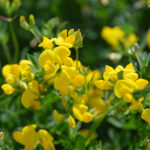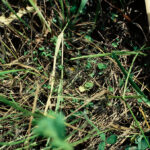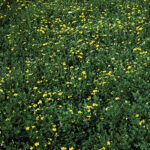Birdsfoot Trefoil
Lotus corniculatus
General Description
Birdsfoot trefoil is a perennial non-bloat legume. It is highly adapted to grow in a range of challenging conditions including infertile soils, soils with high acidity or poor drainage, and poorly prepared seed beds. It can persist in a long-lived stand when allowed to set seed.
It has a wide crown and taproot, intermediate in depth between alfalfa and red clover. Roots sometimes develop from older stems that have soil contact.
The plant produces many fine stems or branches from the crown, which can grow up to 75 cm (30 in) long. Plants can be erect or prostrate. Birdsfoot trefoil has compound leaves with paired leaflets up the stalk and a single leaflet at the tip. Flowers initially form on lower branches and continue up the stem. Flowers are a brilliant yellow and found in clusters of 2 to 8. The name is derived from the way the pods form at right angles to the stem, looking like a bird’s foot.
Type
Tame legume.
Origin
Native to Europe, North Africa, and parts of Asia. Canadian varieties were developed and selected for winter hardiness.
Longevity
Less than 5 years. However, long-lived stands are found frequently where seed set is encouraged and stands are managed for improved winter survival through snow cover, litter cover, and managed grazing intensity.
Use
Pasture, hay. Best suited for pasture, especially in higher rainfall areas. Although used for hay, leaf loss after cutting and difficulty curing are noted for birdsfoot trefoil.
Optimal Time of Use
Spring, summer, fall. A full canopy of leaves and ground cover must be produced before spring grazing. The plant needs late season rest to build root carbohydrate reserves. Hay quality and yield are maximized at early bloom. May be prone to winterkill if grazed on during the winter (eg. bale grazing).
Recovery After Use
Requires an average 45-60 days recovery following grazing (30 days under good conditions). If continually grazed, crowns may be damaged. Birdsfoot trefoil grows from existing green plant material so it is important to leave at least 10 cm (4 in) of leafy residue for regrowth. Should be rested in late summer and fall and allow some seed to set at least every 2 to 3 years to allow for seed production and ensure stand replacement.
If continually grazed, crowns may be damaged. Birdsfoot trefoil grows from existing green plant material so it is important to leave at least 10 cm (4 in) of leafy residue for regrowth. Should be rested in late summer and fall and allow some seed to set at least every 2 to 3 years to allow for seed production and ensure stand replacement. Trefoil has a fall rest period that is about 10 days earlier than alfalfa’s at any given location.
Yield
Yields a lower quantity of forage than alfalfa, but of a higher quality longer into the growing season. Birdsfoot trefoil retains its quality longer into later maturity stages because of better leaf retention and indeterminate growth (i.e., response to current season’s growing conditions).
Palatability/Nutritional Value
Very palatable and non-bloating for ruminants. Feed value is similar to alfalfa. Crude protein at full bloom is approximately 9%. Standing birdsfoot trefoil retains quality (leaf retention and continued growth) better than standing alfalfa.
Very palatable and non-bloating for ruminants. Feed value is similar to alfalfa. Crude protein at full bloom is approximately 9%. Standing birdsfoot trefoil retains quality (leaf retention and continued growth) better than standing alfalfa. Research from Agriculture and Agri-Food Canada has shown that cattle have higher average daily gains on pastures that contain trefoil as the legume compared to alfalfa-based mixes. This may be due to the higher sugar: crude protein ratio in trefoil, which may improve the digestive efficiency of rumen bacteria. It is also possible that higher gains were achieved due to the condensed tannins found in trefoil, which increase the amount of rumen undegradable protein in the forage.
Annual Precipitation min/max (mm)
400mm / 600mm
Drought Tolerance
Fair drought tolerance. Birdsfoot trefoil is adapted best to higher moisture soil zones, but can withstand some drought with its deep taproot.
Flooding Tolerance
Can tolerate 2-5 weeks of flooding, and tolerate wet soils throughout the year.
Winter Hardiness
Variable (poor to good). Winter survival is improved by deep snow cover and adequate rest before frost to protect the plant’s crown.
Soil Texture Preference
Adapted to moist sandy loam to clay soils. Adapted to waterlogged soils or conditions of poor fertility.
Erosion Control
Poor ability to control erosion. However, birdsfoot trefoil is well suited to grow on poor soils.
Salinity Tolerance
Moderate tolerance.
Acidity Tolerance
Moderate tolerance.
Alkalinity Tolerance
Moderate tolerance. Similar to alsike clover.
Seeds per kg
815,000 seeds/kg (370,000 seeds/lb)
Suggested Mixtures
Grasses such as timothy, tall fescue, northern wheatgrass or western wheatgrass have all been successfully seeded with birdsfoot trefoil. Lower growing grasses or legumes may also pair well with birdsfoot trefoil. Pure stands may be desired for short rotations (as persistence may be questionable).
Grasses such as timothy, tall fescue, meadow fescue, orchardgrass, Kentucky bluegrass, and meadow brome have all been successfully seeded with birdsfoot trefoil. Lower growing grasses or legumes may also pair well with birdsfoot trefoil. Pure stands may be desired for short rotations (as persistence may be questionable).
Ease of Establishment
Birdsfoot trefoil seedlings grow slow initially but establish well under good growing conditions with use in the year following seeding. Establishment is enhanced with shallow seeding (3-6 mm/ 1/4 in), control of weeds, and seeding without a cover crop. Seedlings can have weak roots that are sensitive to shade.
Competitiveness
May be more competitive under ‘adverse’ conditions such as acidity or low fertility. Considered weedy or invasive in some regions including along roadsides, field margins, and in urban locations.
Management Considerations
Inoculate seed to enhance nitrogen production. It requires its own specific Rhizobium loti inoculant to fix nitrogen. To improve establishment and longevity, do not graze or cut before full bloom in the first year of establishment. Leave 7 or 8 cm (3 in) or more stubble after grazing as birdsfoot trefoil regrows from existing growth. Do not graze too early in spring or in late summer, 6 weeks before first frost, and allow to set seed every 2 to 3 years to facilitate stand persistence. Birdsfoot trefoil is a great species choice to improve soil conditions without causing bloat in grazing livestock.
Inoculate seed to enhance nitrogen production. It requires its own specific Rhizobium loti inoculant to fix nitrogen. To improve establishment and longevity, do not graze or cut before full bloom in the first year of establishment. Leave 7 or 8 cm (3 in) or more stubble after grazing as birdsfoot trefoil regrows from existing growth. Do not graze too early in spring or in late summer, 7-8 weeks before first frost, and allow to set seed every 2 to 3 years to facilitate stand persistence. Birdsfoot trefoil is a great species choice to improve soil conditions without causing bloat in grazing livestock.
British Columbia Rangeland Seeding Manual, Saskatchewan Dryland Forage Species Adaptation Tool, USDA Plants Database, Alberta Forage Manual, Manitoba Forage Adaptation and Comparison Guide
British Columbia Rangeland Seeding Manual, Saskatchewan Dryland Forage Species Adaptation Tool, USDA Plants Database, Alberta Forage Manual, Manitoba Forage Adaptation and Comparison Guide, Publication 30 (OMAFRA) BÉLANGER, G., G.F. TREMBLAY, Y.A. PAPADOPOULOS, J. DUYNISVELD, J. LAJEUNESSE, C. LAFRENIÈRE et S.A.E. FILLMORE. 2017. « Yield and Nutritive Value of Binary Legume-Grass Mixtures Under Grazing or Frequent Cutting », dans Canadian Journal of Plant Science, vol. 98, no 2, 2017, p. 395-407.
Birdsfoot trefoil is adapted to the Sub-Boreal Spruce, Sub-Boreal Pine-Spruce and Interior Cedar-Hemlock zones. In the southern part of the Central Interior it is adapted to wetter parts of the Interior Douglas-fir zone, and to irrigated and subirrigated areas in the Bunchgrass zone and dry parts of the Interior Douglas-fir zone. New varieties have better establishment characteristics and are better adapted for pasture use.
Birdsfoot trefoil has limited dryland adaptability and is suited to wetter areas in the region (i.e., the Interior Cedar-Hemlock Zone and wetter parts of the Interior Douglas-fir zone) or to irrigated or subirrigated areas in the Bunchgrass, Ponderosa Pine and Interior Douglas-fir zones. New varieties have better establishment characteristics and are better adapted for pasture use.
Birdsfoot trefoil is not noted for its winter-hardiness however, there are examples of long-lived stands in the Peace-Liard region. Snow cover is important for winter survival. Birdsfoot trefoil may be worthy of consideration on sites that have insufficient drainage for alfalfa. New varieties have better establishment characteristics and are better adapted for pasture use.



